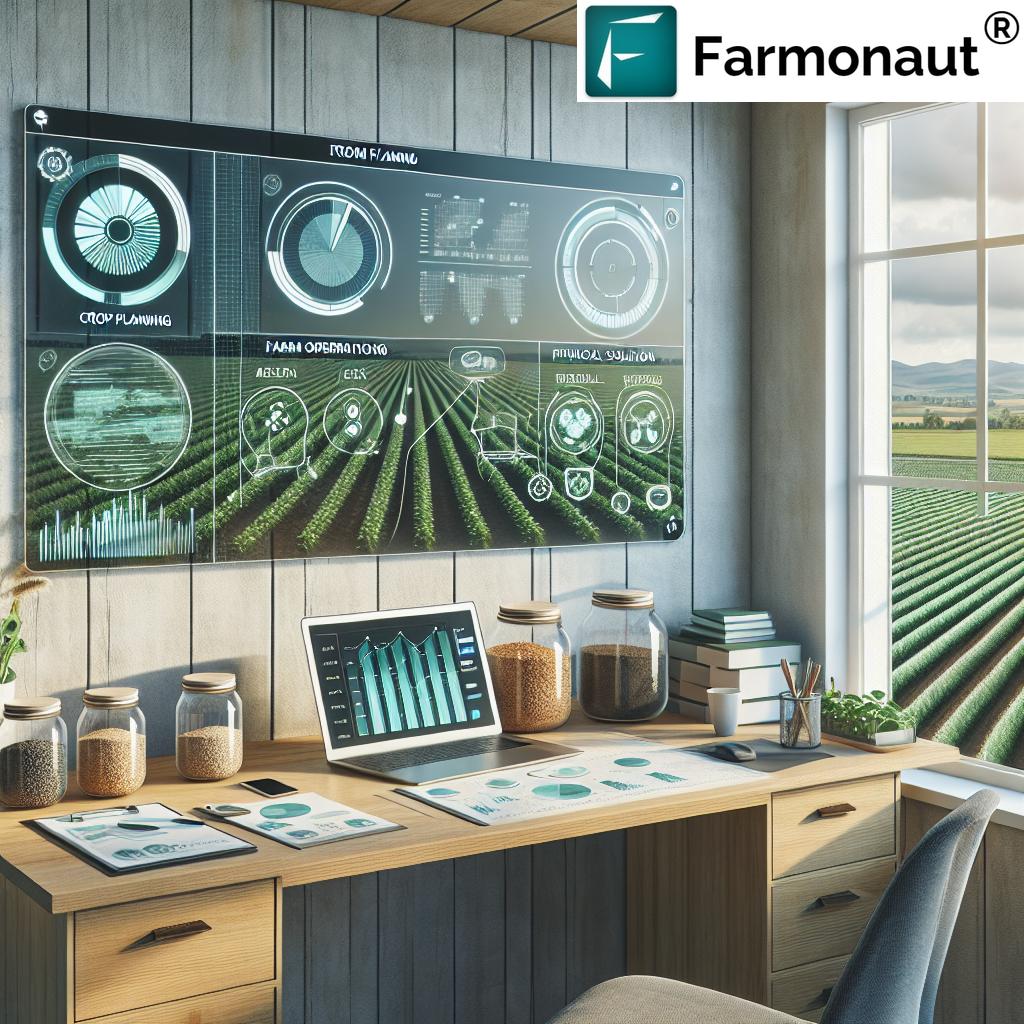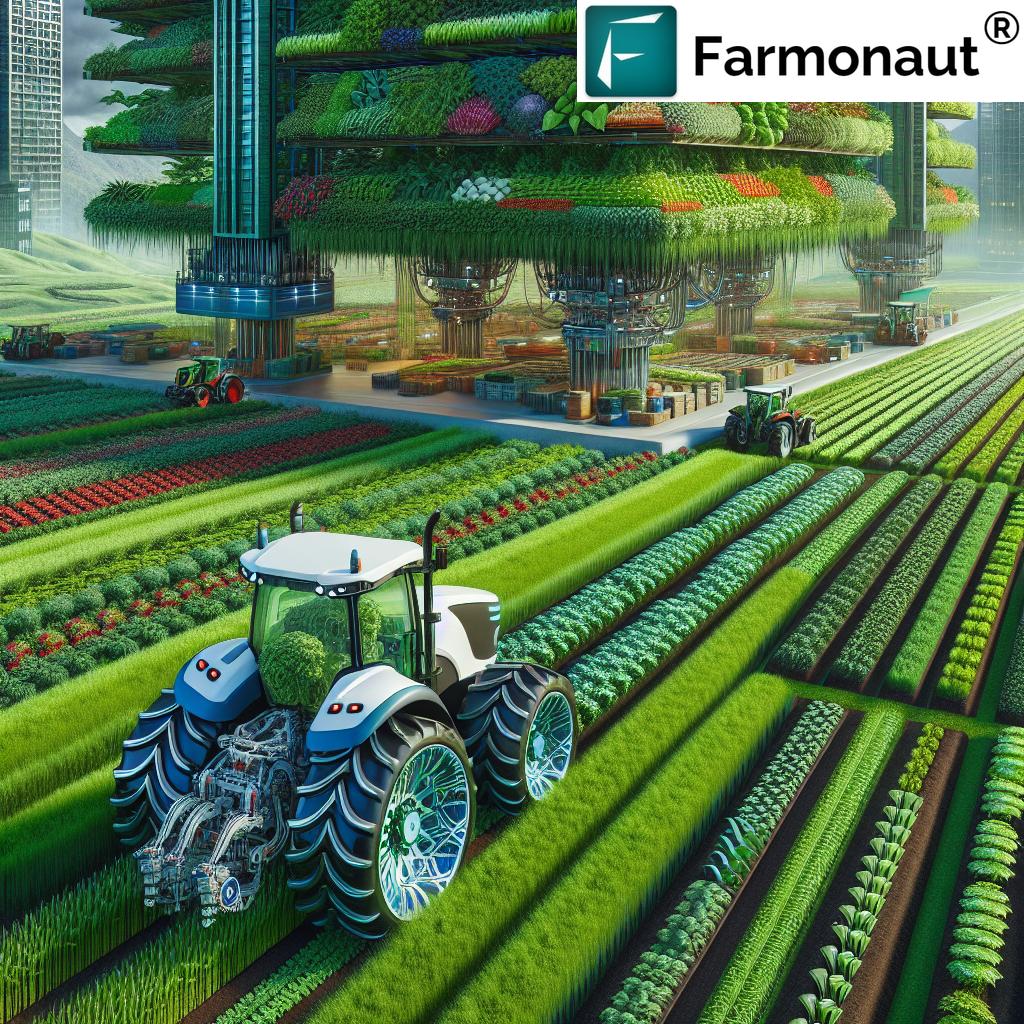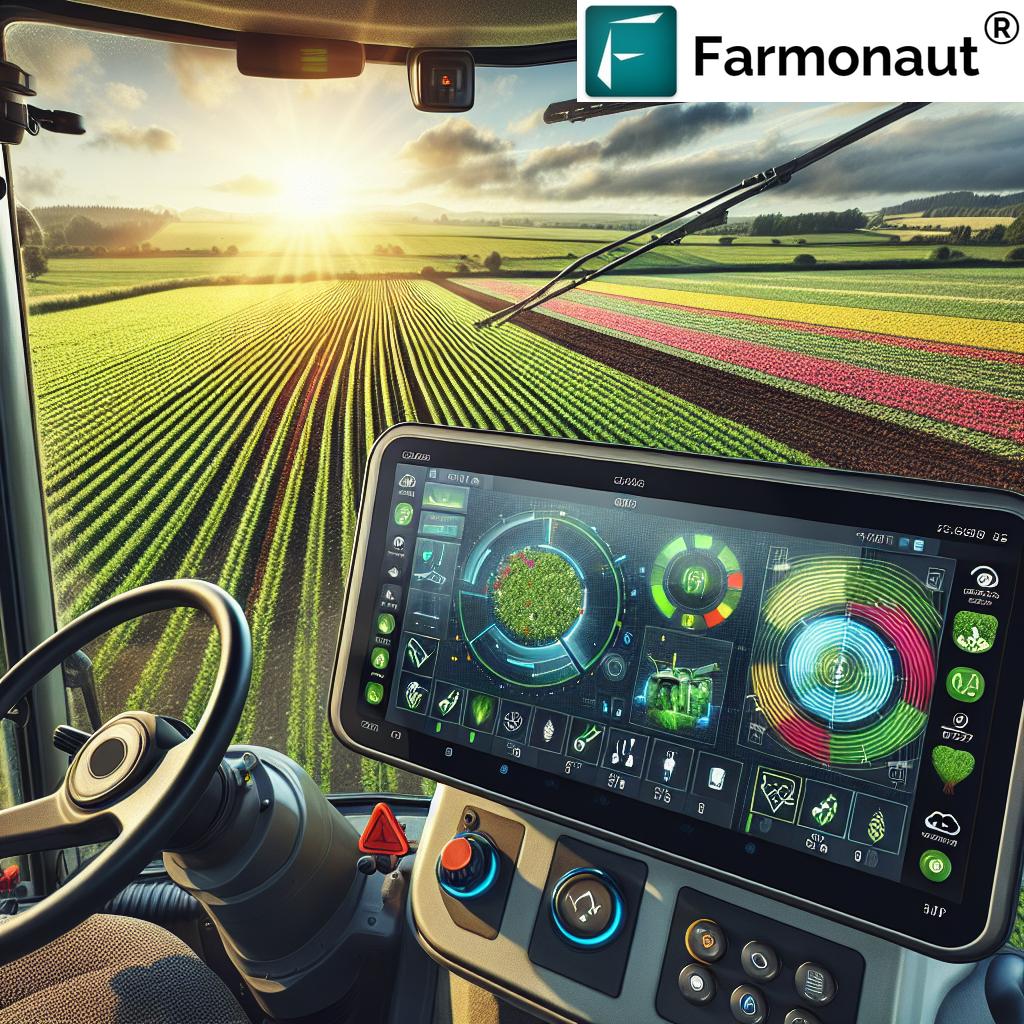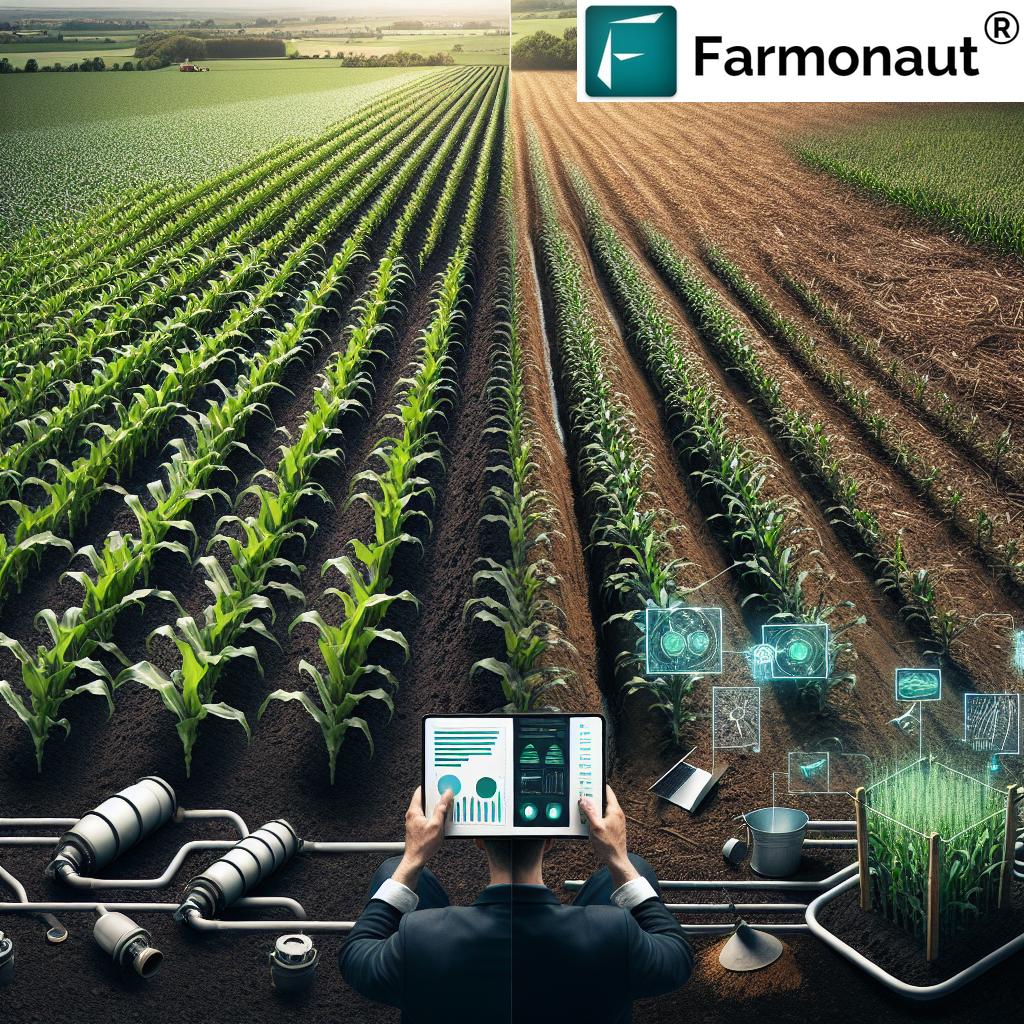Variable Rate Irrigation Work Principles & 7 Benefits: Transforming Precision Agriculture Irrigation
Table of Contents
- Introduction
- Principles of Variable Rate Irrigation
- Types of Variable Rate Irrigation Technologies
- Major Components of a VRI System
- How Variable Rate Irrigation Operates
- 7 Major Benefits of Variable Rate Irrigation
- Comparative Table: Traditional vs VRI Systems
- Advanced Sensors & Sensing in Precision Agriculture Irrigation
- Integrating VRI with Farmonaut’s Precision Agriculture Solutions
- Challenges & Considerations in VRI Implementation
- The Future of Variable Rate Irrigation & Precision Agriculture
- Get Started with Farmonaut
- FAQs on Variable Rate Irrigation
“Variable Rate Irrigation can reduce water usage by up to 30% compared to traditional irrigation methods.”
Introduction: Why Variable Rate Irrigation is the Future of Water Management in Farming
In today’s age of precision agriculture, optimizing water usage is not just a smart business move — it’s a necessity for sustainable farming. Variable Rate Irrigation (VRI) is one of the most significant technological advancements reshaping agricultural practices, allowing us as farmers, agronomists, and stakeholders to tailor irrigation across fields to their unique characteristics. Unlike traditional “one-size-fits-all” irrigation systems, VRI empowers us to apply water at different rates in different zones, based on real-time field data about soil, crop, and moisture status.
Leveraging advanced sensors and decision systems, this technique focuses on the efficient application of every drop, enhancing crop yields and promoting sustainable irrigation practices. As a result, farms can significantly reduce water usage, decrease input costs, and improve both productivity and profitability.
In this comprehensive guide by Farmonaut, we’ll explore how Variable Rate Irrigation functions, examine its main technologies, and break down its core benefits for modern agriculture. We’ll also discuss how advanced solutions—such as those offered by Farmonaut—can integrate with VRI to maximize returns, conserve resources, and support environmentally conscious farming decisions.
Principles of Variable Rate Irrigation
The foundation of Variable Rate Irrigation is the understanding that fields are not uniform. Any experienced grower knows that, within a single field, the soil type, topography, plant growth, and moisture availability can exhibit significant variations. Traditional systems apply one blanket irrigation rate, ignoring these differences. In contrast, VRI operates on mapping and recognizing this natural variability.
- Soil Texture & Moisture: Sandy soil drains faster, clay holds water—VRI ensures the right amount of water for each.
- Topography: Slopes, low spots, and elevated zones impact water retention and runoff.
- Crop Stage & Health: Different growth stages or stressed areas require tailored water application.
- Historical Data: Past yield maps, weather data, and remote sensing inform smarter decisions.
By recognizing these differences, VRI helps us match irrigation rates to real needs in each field zone, leading to improved crop health, reduced waste, and efficient resource use.
Why Precision Matters: Variable Rate vs Uniform Irrigation
- Variable: Each zone in the field receives water tailored to its needs—no excess, no deficiency.
- Uniform: Some areas get too much (risking runoff and nutrient loss), others too little (risking yield loss).
With VRI, we take the guesswork out of irrigation, turning fields into intelligent, responsive production zones backed by data-driven management decisions.
“Advanced sensors in precision agriculture can increase crop yields by as much as 20% with optimized water management.”
Types of Variable Rate Irrigation Technologies
VRI systems can be broadly categorized into two main types, each offering a unique approach to water application and suited for different levels of field variability:
-
Speed Control VRI
This method adjusts the movement speed of mechanized irrigation systems (such as center pivot or linear move machines), directly affecting the amount of water applied at any point. When moving slower, the system applies more water; when moving faster, it reduces application rates accordingly.
Best for: Large-field variability where zonal boundaries aren’t sharply defined.
-
Zone Control VRI
In this approach, irrigation hardware is divided into multiple zones, often clusters of sprinklers grouped together and programmed to operate independently. Each zone can deliver a unique rate of water based on soil, crop, and topography data. This method delivers much finer precision, especially for localized or micro-variations across a field.
Best for: Fields with complex soil or topographic variability requiring targeted management.
Both types are major leaps in efficiency compared to traditional uniform irrigation, but your choice depends on your field’s unique needs and management goals.
Major Components of a Modern VRI System
-
Irrigation System Hardware:
- Center pivots, linear-move machines, sprinklers, pipes, hoses, and valves ensure flexible, reliable water distribution.
- Zone-based controls enable individual sections or spans to deliver variable water rates.
-
Control System (Software & Electronics):
- An intelligent control panel (often cloud-integrated) manages programming and real-time operation.
- Mobile app access lets us remotely adjust irrigation schedules, water rates, and monitor hardware.
-
Sensing & Measurement Systems:
- Soil moisture sensors for irrigation deliver continuous feedback on field conditions.
- Other devices like weather stations, rain gauges, and infrared cameras supply essential data.
- Remote sensing (satellite-driven insights like those from Farmonaut) further enhance data-driven management.
The interplay between these components underpins efficient irrigation system operation, applying water precisely, and maximizing irrigation system efficiency.
How Variable Rate Irrigation Operates in Real Farms
At the heart of VRI lies continuous, data-driven adjustment of how and where water is applied—unlocking the full potential of precision agriculture irrigation. Here’s a step-by-step look at the VRI workflow:
-
Field Analysis & Mapping:
- We begin by capturing soil maps, terrain models, historical yield data, and remote sensing imagery.
- Farmonaut’s platform utilizes satellite imagery for accurate, up-to-date crop health and soil moisture mapping.
-
Zone Definition:
- Using this rich data, we divide the field into management zones with similar characteristics.
- These zones could be topographic sections, soil types, or crop growth classes.
-
Recipe Programming & Automation:
- We program the control software to deliver the right water rate to each zone.
-
Real-Time Monitoring & Adjustment:
- Using soil moisture sensors for irrigation, weather data, and satellite imagery, the system continuously adapts water rates for optimal outcomes.
-
Cloud-Enabled Optimization:
- The process can be managed onsite or remotely—with Farmonaut’s app, monitoring and adjustments can happen from anywhere, at any time.
This adaptive, intelligent approach ensures each zone receives the precise water quantities it needs, dramatically improving water use efficiency and supporting sustainable irrigation practices.
Comparing Traditional vs Variable Rate Irrigation: Quantifying the Benefits
| Parameter | Traditional Irrigation (Estimated Values) | Variable Rate Irrigation (Estimated Values) |
|---|---|---|
| Water Use Efficiency (%) | 55–65% | 80–90% |
| Average Yield Increase (%) | Baseline (0%) | 10–20% |
| Energy Consumption (kWh/ha) | 150–200 | 100–140 |
| Input Cost Savings ($/ha) | $0–$40 | $60–$100+ |
| Crop Health Index | Medium | High |
| Reduction in Water Runoff (%) | 0–10% | 30–50% |
| Labor Requirement (hours/ha) | 6–10 | 3–5 |
*Values are indicative and may vary by crop, location, and individual system performance.
It’s clear that the shift to precision VRI systems means higher yields, lower input costs, and far better water efficiency—even as water scarcity and sustainability demands rise worldwide.
7 Powerful Benefits of Variable Rate Irrigation
Why should modern farms and agribusinesses embrace VRI? Here are the top seven benefits transforming agriculture globally:
-
Water Conservation
VRI reduces water usage in agriculture by ensuring water is applied only where and when it’s needed, minimizing waste and contributing tangibly to sustainability goals. -
Enhanced Crop Yields
By tailoring irrigation to soil and crop requirements, VRI systems cut down plant stress, improve nutrient uptake, and lead to visibly improved yields. -
Lower Production & Input Costs
With smarter water use, we see decreased energy (from reduced water pumping), reduced labor, and lower spend on herbicides and fertilizers since water application aligns perfectly with crop demand. -
Improved Water Use Efficiency
VRI achieves up to 90% irrigation system efficiency (vs 60% for traditional). This results in every drop working harder for your bottom line and resource stewardship. -
Environmental Benefits
Tailored irrigation limits water runoff, curtails soil erosion, and reduces nutrient leaching—protecting local water quality and supporting sustainable farming practices. -
Suppression of Weeds & Disease
Drier non-cropped areas (like pivots’ wheel tracks, borders, or pathways) are less conducive to weed growth and disease spread, translating to less manual or chemical intervention. -
Data-Backed, Scalable Decision-Making
Through detailed sensing, monitoring, and reporting, VRI makes it easy to take what works, scale it across more hectares, and adapt quickly as farm conditions change.
How VRI Advances Sustainability in Precision Agriculture Irrigation
- Decreasing water withdrawal from sensitive aquifers & rivers
- Promoting climate-resilient farming by adapting to changing rainfall patterns
- Supporting carbon footprint reduction—less energy, fewer emissions. (Explore Farmonaut’s carbon footprinting product page for advanced, real-time monitoring tools!)
Advanced Sensors & Sensing in Precision Agriculture Irrigation
What makes VRI so effective—and so different from conventional approaches—is the seamless integration of advanced sensors and data-driven technologies. Today, systems like Farmonaut leverage a combination of:
- Soil Moisture Sensors for Irrigation: Give real-time, on-the-ground feedback that drives every control action.
- Remote Sensing: Satellite-derived indices such as NDVI (Normalized Difference Vegetation Index) reflect crop health and variability across the field in rich detail.
- Weather & Environmental Sensors: Monitor rainfall, temperature, and evapotranspiration—informing irrigation needs dynamically.
- Control & Automation Devices: Embedded electronics harmonize data from all sources, automating optimal irrigation recipes by zone.
The result? Every zone in the field is managed with near-laboratory precision, ensuring no drop is wasted. This enables smarter, sustainable irrigation practices that benefit both yields and the planet.
How Does Farmonaut Help with Advanced Resource Management?
Managing diverse zones and massive field operations? Explore Farmonaut’s Fleet Management solution, which streamlines agricultural logistics, optimizes farm vehicle deployment, and integrates effortlessly with variable-rate resource management.
Need greater transparency in your supply chain? Farmonaut’s Blockchain-based Traceability ensures every product stage is verifiable—ideal for food, textile, and large-scale agricultural supply chains!
Integrating VRI with Farmonaut’s Precision Agriculture Solutions
At Farmonaut, our goal is to make precision agriculture affordable and accessible worldwide. By seamlessly marrying satellite-based crop and soil health monitoring with actionable insights for irrigation management, we help farmers of all scales make the most out of their VRI investments:
-
Satellite Crop Health & Soil Moisture Data:
- Our platform uses multispectral imagery to offer timely, actionable maps of your field’s conditions—perfect for defining and adjusting VRI zones.
-
AI-Based Advisory:
- With Jeevn AI, you get personalized water application guidance that syncs with VRI system needs—direct from your phone, tablet, or browser.
-
Automated Resource Management:
- Cut costs, save time, and ensure maximum efficiency through real-time resource allocation, accessible via Farmonaut’s easy API integrations.
Interested in integrating Farmonaut’s satellite and weather data into your custom VRI management system? Check out our robust API and API Documentation—empowering developers and agribusinesses to deliver advanced irrigation technologies at scale!
If you manage large-scale farm operations, explore Farmonaut’s Large Scale Farm Management app to streamline farm oversight, crew management, and data consolidation for better VRI execution.
Choose Your Farmonaut Subscription & Make Your Farm Data-Driven
Stay on top of every irrigation and farm management need. Begin your affordable, precision-driven journey here:
Challenges & Considerations in VRI Implementation
- Initial Investment: Deploying VRI—upgrading hardware, adding sensors, and mapping zones—requires capital outlay. However, long-term savings on water, inputs, and yield improvements often outweigh this cost.
- Technical Complexity: VRI demands a higher degree of management, troubleshooting, and digital literacy compared to “set-it-and-forget-it” irrigation. Quality training and support—like that provided through the Farmonaut platform—are key.
- Data Management: With numerous devices generating constant data flow, organizing, interpreting, and putting insights into action can challenge busy producers—unless you use robust decision-support systems.
- Field Variability: Highly complex or fragmented fields may require careful planning and periodic adjustment of management zones as cropping strategies evolve.
Despite these challenges, the long-term payoffs—financial, environmental, and operational—make VRI a smart investment.
The Future of Variable Rate Irrigation & Precision Water Management
As climate volatility, changing rainfall patterns, and freshwater scarcity redefine agriculture’s future, Variable Rate Irrigation stands as a transformative tool for resilient, sustainable irrigation practices. We can expect:
- Further automation and integration: Seamless linking of VRI systems with AI-driven advisories, blockchain traceability, and remote crop monitoring platforms like Farmonaut.
- Increased accessibility: As costs drop and digital connectivity rises, even smallholders can harness VRI’s efficiency via mobile and web tools.
- Ecosystem-wide resource optimization: With APIs and scalable farm management apps (explore Farmonaut’s enterprise solutions), fleets, water, nutrition, and supply chain transparency can all be managed together on a single platform.
- Policy and sustainability incentives: Governments and development institutions worldwide are rewarding reducing water usage in agriculture, making systems like VRI the new standard for progressive growers.
By combining variable rate technology with innovation leaders like Farmonaut, we’re not just irrigating smarter—we’re building the resilient, productive, and environmentally sound agriculture of tomorrow.
Get Started with Farmonaut: Your Partner in Precision VRI and Beyond
The journey to maximum water use efficiency, robust yields, and sustainable resource usage begins with precision data. With Farmonaut’s platform, you gain access to:
- Real-time crop, moisture, and field data via satellite
- AI-powered advice on irrigation, fertilizer, and pest management
- Mobile, web, and API access—anywhere, anytime
- Scalable solutions—from individual parcel management to large-scale farm administration
- Integrated resource, fleet, and traceability tools for full-farm optimization
Ready to revolutionize your water management in farming, boost your yields, and future-proof your operations?
Or, for large-scale, institutional, or integrated operations, explore our API platform or consult our developer documentation.
Lastly, secure your harvest and access affordable financing with Farmonaut’s crop loan & insurance verification solutions—backed by satellite data.
The age of variable rate irrigation, actionable data, and smart resource management starts now. Join the global community of data-driven farmers and experience the Farmonaut advantage!
FAQs on Variable Rate Irrigation (VRI) & Precision Agriculture
1. What is Variable Rate Irrigation (VRI)?
Variable Rate Irrigation is a system that enables us to apply different amounts of water to different areas (“zones”) of a field based on their specific needs, instead of delivering a uniform amount everywhere. This approach is powered by data and advanced control systems.
2. Can VRI work on any type of field or farm?
VRI delivers the most value on fields with significant variations in soil texture, topography, or crop growth patterns. Both small and large farms can benefit—especially those seeking to optimize input use and become more sustainable.
3. Is VRI complicated to manage?
It is more complex than standard irrigation, involving digital controllers, mapping, and sensors. However, modern systems (like Farmonaut) streamline the process, offering training, support, and user-friendly digital dashboards.
4. What hardware or technologies do I need for VRI?
Typically, you’ll need: (1) a compatible mechanized irrigation system (like center pivots or linear move units), (2) system upgrades for speed or zone control, (3) soil moisture sensors and optionally, (4) digital integrations for remote sensing, mapping, and control.
5. How does Farmonaut connect with my irrigation practice?
Farmonaut offers crop, moisture, and field monitoring via satellite—delivering precise, actionable maps for zone definition. Our platform, apps, and API empower you to use the data for smart irrigation management, yield prediction, and resource tracking. API endpoints can be connected to your digital infrastructure for end-to-end automation.
6. Is VRI a cost-effective investment?
Yes. Although the initial investment may seem significant, most farms recoup costs by reducing input, labor, and energy expenses—often within just a few seasons—while securing higher or more consistent yields.
7. What’s the environmental impact of switching to VRI?
VRI conserves water, reduces water runoff and nutrient leaching, and shrinks your farm’s carbon footprint—a win for farm economics and for sustainability targets.
8. Where can I learn more or start using precision farming solutions?
Download the Farmonaut Android App, iOS App, or access the web platform to start exploring actionable insights for your fields today!
Variable Rate Irrigation, powered by real-time data and advanced sensing, represents the pinnacle of modern, sustainable agriculture. When combined with precision platforms like Farmonaut, it arms farmers and agribusinesses with the tools needed to thrive under tomorrow’s challenges.
Take charge of your farm’s water, productivity, and future—with Farmonaut and variable rate irrigation.






















